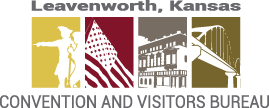Wayside Tour #7: Stockton Hall - "The Liberator and the Assassin"
Wayside Tour #7: Stockton Hall - "The Liberator and the Assassin"
Leavenworth's Stockton Hall was built in 1857 at the southwest corner of Fourth and Delaware streets. Although not the first of the town's public halls, Stockton was to become the most famous. It was a frame building forty-five by one hundred and twenty feet, with storerooms on the ground floor. The upper floor was combination meeting hall and theater frequently used by traveling theatrical troupes.
Stockton Hall took its name from its promoter, Captain J. B. Stockton, described in an early history of Leavenworth City and county as "a prominent public spirited citizen and hustler." When the Civil War broke out Captain Stockton commanded Company G, First Kansas Volunteers.
In the summer of 1858 a meeting was held at Stockton Hall which gave birth to the Democratic Party in Kansas. Prominent Democrats of the Kansas Territory and old line Whigs with similar political views adopted a platform, which became the foundation for the Democratic Party here.
In December of 1859, Stockton Hall was filled to capacity to welcome a visitor from Illinois. Citizens of Leavenworth were eager to hear the man who had debated Stephen A. Douglas. Those debates cast Abraham Lincoln into the national spotlight, and Lincoln was making a speaking tour of towns in the Kansas Territory.
On the night of December third, 1859, Lincoln took the stage in Stockton Hall and spoke at length on "Popular Sovereignty" and the principles of the Republic's founding fathers. Lincoln spoke of the likelihood of statehood for the Kansas Territory and the need to maintain a position opposing slavery.
Exactly four years to the month after Lincoln's Stockton Hall address, a touring theatrical troupe appeared on the same stage. One of the actors was John Wilkes Booth, whom the New York newspapers said was touring the country "with the most triumphant success." Barely sixteen months later Booth went to Ford's Theater in Washington, D. C., where he assassinated President Lincoln.



